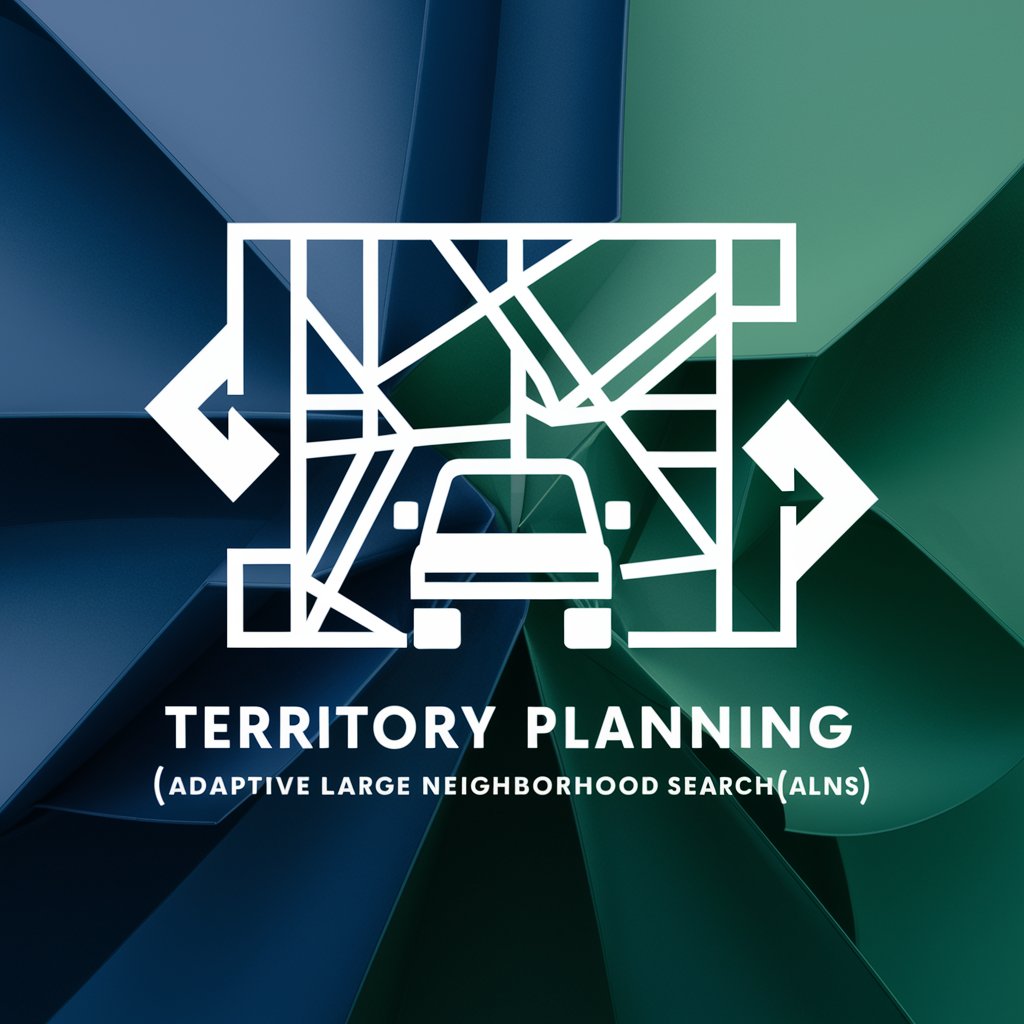ALNS and Territory Planning Expert - ALNS Territory Planning

Welcome! Let's optimize your territory planning strategies.
Optimizing logistics with AI-driven territory planning.
Explain the concept of territory planning in the context of...
How does Adaptive Large Neighborhood Search (ALNS) optimize...
What are the key trade-offs involved in multi-objective...
Can you describe the methodology used for integrating territory planning...
Get Embed Code
Introduction to ALNS and Territory Planning Expert
The Adaptive Large Neighborhood Search (ALNS) and Territory Planning Expert is designed to tackle complex logistics and territory planning challenges, specifically within the context of residential waste collection problems. It employs an integrated approach to optimize territory assignments and vehicle routing, balancing multiple objectives such as minimizing travel time, reducing route overlaps, and ensuring balanced workload among collection vehicles. This optimization tool is crucial for enhancing operational efficiency in waste collection services, where efficient route planning can lead to significant cost savings and environmental benefits. An example scenario involves a municipal waste management authority seeking to redesign its collection routes to improve service efficiency. By applying the ALNS method, the authority can generate optimized routes that minimize operational costs while ensuring equitable workload distribution and reducing environmental impact. Powered by ChatGPT-4o。

Main Functions of ALNS and Territory Planning Expert
Integrated Territory Planning and Vehicle Routing
Example
Creating optimized collection territories that reduce overlaps and ensure compactness, while planning efficient vehicle routes within each territory.
Scenario
A city's waste management service uses the tool to divide the city into optimized collection zones, where each zone is serviced by a designated vehicle following an optimized route. This leads to improved collection efficiency and reduced fuel consumption.
Multi-Objective Optimization
Example
Simultaneously optimizing for minimum travel time, minimum overlap, and balanced workload among vehicles.
Scenario
A waste collection company aims to overhaul its collection operations to achieve cost savings. By prioritizing these objectives, the company can identify a solution that minimizes operational costs while ensuring fair workload distribution and service reliability.
Pareto Frontier Analysis
Example
Identifying non-dominated solutions across different objectives to facilitate informed decision-making.
Scenario
A municipal council wants to understand the trade-offs between operational efficiency and environmental impact. Through Pareto frontier analysis, the council can evaluate various scenarios to find an acceptable balance between reducing travel distances (and thus emissions) and ensuring equitable workload distribution.
Ideal Users of ALNS and Territory Planning Expert Services
Municipal Waste Management Authorities
Authorities seeking to enhance residential waste collection efficiency, reduce operational costs, and minimize environmental impact would benefit from using ALNS and Territory Planning Expert to optimize their collection systems.
Environmental Consultants
Consultants working on optimizing logistics and operations for sustainability projects can use this tool to develop efficient and environmentally friendly waste collection strategies for their clients.
Logistics and Transportation Planners
Professionals involved in planning and managing complex vehicle routing and territory assignments, particularly in sectors requiring frequent and regular visits to numerous locations, can leverage the tool's capabilities to streamline operations.

Using ALNS and Territory Planning Expert: A Step-by-Step Guide
Start Free Trial
Begin by exploring yeschat.ai for a complimentary trial, accessible without any requirement for login or subscription to ChatGPT Plus.
Understand the Basics
Familiarize yourself with the concepts of Adaptive Large Neighborhood Search (ALNS) and Territory Planning through the provided tutorials and documentation. This foundational knowledge is crucial for effective utilization.
Define Objectives
Clearly outline your objectives for territory planning and vehicle routing, considering aspects like minimizing travel time, reducing overlaps, and ensuring balanced workloads.
Implement Strategies
Utilize the tool to implement territory planning and vehicle routing strategies. Experiment with different settings to observe how changes affect outcomes like travel efficiency and workload distribution.
Analyze and Optimize
Analyze the results using the tool's reporting features. Use insights gained to refine your strategies, focusing on achieving an optimal balance between your defined objectives.
Try other advanced and practical GPTs
Dev Coffee-Themed Humor
Brewing Humor with AI-Crafted Coffee Puns

Humor with Kevin Hart and Brendon
Elevate your humor with AI-powered insights

Humor Haven
AI-powered personalized humor at your fingertips

Coffee-Themed Humor Generator
Brew creativity with AI-powered humor.

Humor Weaver
Transform Media into Humor with AI

Professor Humor
AI-powered humor enhancement

Territory Assistant
Streamline your territory data integration effortlessly with AI.

Consistent duplicator
Bringing Characters to Life with AI-Powered Manga Art

Consise Coding Answers
Instant coding fixes, powered by AI

Consistent Character and Photo Manipulation
Transform Photos with AI Precision

Consistant Character Crafter
Craft and evolve characters with AI

Consistent Character GPT
Bringing Characters to Life with AI

Frequently Asked Questions about ALNS and Territory Planning Expert
What is Adaptive Large Neighborhood Search (ALNS)?
ALNS is a heuristic method used in solving complex optimization problems, particularly effective in territory planning and vehicle routing. It iteratively improves solutions by destructing and repairing parts of the solution, aiming to find high-quality solutions within a reasonable computational time.
How does territory planning benefit waste collection management?
Territory planning optimizes waste collection by dividing areas into manageable territories. This enhances route efficiency, reduces operational costs, and ensures balanced workloads among collection vehicles, leading to more predictable and reliable waste collection services.
Can ALNS handle multi-objective optimization problems?
Yes, ALNS is particularly suited for multi-objective optimization problems. It can effectively handle trade-offs between conflicting objectives, such as minimizing travel time, reducing route overlaps, and balancing workloads, making it ideal for complex problems like residential waste collection.
What are common challenges in territory planning and vehicle routing?
Common challenges include dealing with variable demand, ensuring equitable workload distribution, minimizing travel distances and times, avoiding route overlaps, and adapting to real-world constraints like traffic conditions and vehicle capacities.
How does one evaluate the success of an ALNS implementation?
Success can be evaluated based on the algorithm's ability to find efficient, realistic solutions that meet or exceed predefined objectives. Key performance indicators include reduction in operational costs, improvement in service levels, and achievement of a balanced workload among routes.
